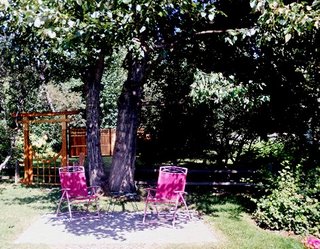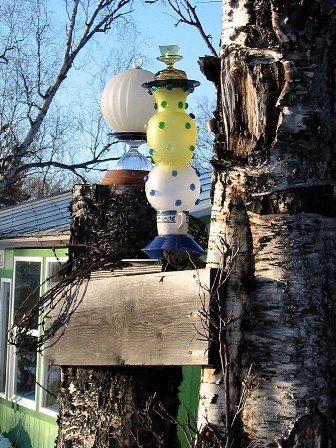Finally, a new garden club to join! And this one is for the underdog, what more could you ask for? It's really easy - just log onto comments and tell us you're in. ‘Save the Cottonwood Society’s time is here!
Populus balsamifera ssp trichocarpa, known more commonly as Black Cottonwood, or just ‘cottonwood’ here in our Valley, is spectacular, underrated and abused. If it sounds like I’m about to defend this tree, you’re right. It’s been systematically annihilated for years. It’s a big, humble tree that’s treated like a dispensable weed. Well, it’s neither a weed nor is it dispensable. If you’ve chopped them down and cursed the name, please read on. This column’s for you!
Cottonwood can reach amazing heights – up to one hundred and twenty feet! This makes it the tallest broad leafed tree in Alaska. Its rapid growth habit means you don’t have to wait your whole life for the wind breaking and shade giving qualities it provides. We have a lovel
 y, thirty foot specimen in our back yard that wasn’t even there when we moved in twelve years ago! This photo shows an award winning garden in North Palmer. The gardener’s have groomed a pair of these giants for years. It is a thing of beauty and shelters a small patio under its wonderful branches.
y, thirty foot specimen in our back yard that wasn’t even there when we moved in twelve years ago! This photo shows an award winning garden in North Palmer. The gardener’s have groomed a pair of these giants for years. It is a thing of beauty and shelters a small patio under its wonderful branches. Cottonwood also can keep the air in your garden clean. Read on.
The soil surrounding these trees nutures a colony of special macrobiotic organisms that live only around cottonwood roots. These organisms transfer carbon from the tree roots to the soil. Carbon is also captured in the above ground portion of the tree which, when combined with the root community, creates a system of air filtration for the carbon dioxides emitted into our atmosphere, and effectively slows the increase in harmful atmospheric carbon dioxide concentrations. While all trees perform a similar duty, the cottonwood has one of the fastest and most efficient rates of carbon sequestering. Cottonwoods also increase soil’s fertility and ability to hold water. This saves on the need for erosion control as well as cutting down the need for manmade, fossil-fuel- eating, fertilizers. Important stuff! After all, what is the plan for dealing with our atmosphere when our trees have been reduced to a marginal level? I don’t have one, do you?
The waxy resin in cottonwood buds is used by bees to caulk, and seal out intruders such as mice, or other insects that might bring disease and destruction into their hives. The chemical in this resin is also being developed for tree trunk paint to keep rabbits and mice from girdling them in winter. The same resin holds anti-infectant properties and is used in many modern health ointments and soaps. Soap made from the early buds is magical. It leaves the hands feeling clean and smooth as though lotion had been applied. Of all the wonderful herbal soaps my Mother makes, her Cottonwood Balm is my favorite,and soooo good after a long day in the dirt.
The deep, cracked bark of this mighty tree is a major over-wintering habitat for butterflies, bats and spiders. Cottonwood trees are also a valuable bird sanctuary and their foliage, twigs, buds, flowers and roots provide food for many small creatures, such as shrews, voles, squirrels, porky pine and beaver.
My father, Jerome Koppenberg, is one of Alaska’s most knowledgeable log home builders, and while he prefers using spruce because of its relative lightness, easy peeling and cutting, he says that cottonwood is not without value. As a testament to this, there are two wonderful, cottonwood log homes, built by him, on Lazy Mountain. He lists, among its attributes, its height and straightness, its size – each, single, round easily replacing several of spruce, its superior insulating qualities and its longevity.
Now, lets talk about what you’ve all been waiting for. The cotton! For starters, not all trees produce the dreaded stuff. While both male and female trees can potentially flower, the male catkins are fairly cotton-less and only get up to a couple inches long. The females are the trouble makers with catkins up to eight inches long! But even these beauties, if kept in the back yard or on the edge of your woods, should be welcome. No flowers will appear until the trees are ten years old. Think of the joy and the height a cottonwood can bring you in ten years?
Converted to a cottonwood lover? Good! Remember, cottonwood can only provide its many benefits if left standing. Embrace these majestic giants and enjoy a warm, fuzzy feeling every time you swallow cotton on the breeze. One more thing! Don’t forget to join the ‘Save the Cottonwood Society' and tell us your favorite Cottonwood story. It’ll do your heart good.



6 comments:
Sign me up! I hate the way these majestic trees are treated! Bud Weston, MN.
Great Article! Thanks! Cynde
Greetings Divas!
Thanks for getting your Alaskan gardening blog up and running. I've been enjoying your column in the Frontiersman and I've marked your blog in my Favorites.
I have a couple of giant cottonwood trees in my yard, and now I'll condiser them in a new light. When my kids were little, they used to get the long white cottonwood fuzzies, put them on a leaf and call them polar bear worms. They thought it was hilarious.
Keep up the good work...and I think spring is finally here.
Bridgette (near Bogard Rd.)
My favorite memory of a cottonwood was brought to mind as I read your article. I was a budding arborist (pun intended) working for a college campus. There were several large cottonwood trees that need some large dead limbs removed that were threatening pedestiran traffic.
We climbed to remove them and upon my decent, Islipped and fell. Luckily I was wearing the proper gear and was caught by my rope and harness. We all had a good laugh after I caught my breath... The view from the top of this tree was amazing!
Great article, thanks for bringing back a funny memory.
Chris (Kent, WA)
Thanks so much for this GREAT article! I'm writing a book about cottonwood trees and would love to include mention of your "Save the Cottonwoods Society" (that makes at least 2 out there...can it be a trend?).
Please e-mail me, Sally, I would love to chat a little more about these fabulous trees! And thanks again!
Kathleen Cain
countessk@earthlink.net
You didn't mention the gentle clapping sound the leaves make in the breeze. It's the sound of summer. I love it. Not summer---it's too hot here in Austin to love summer, but shady cottonwoods do make the heat more bearable. More power to you!
Post a Comment